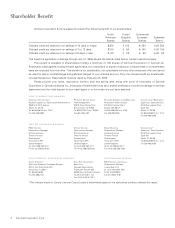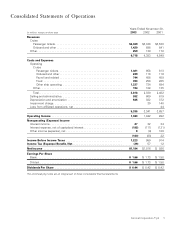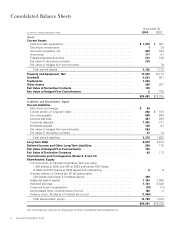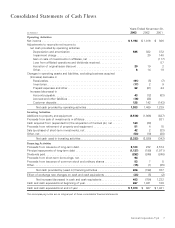Carnival Cruises 2003 Annual Report Download - page 16
Download and view the complete annual report
Please find page 16 of the 2003 Carnival Cruises annual report below. You can navigate through the pages in the report by either clicking on the pages listed below, or by using the keyword search tool below to find specific information within the annual report.13Carnival Corporation & plc
The Black-Scholes option-pricing model was developed
for use in estimating the fair value of traded options
that have no vesting or trading restrictions and are fully
transferable. In addition, option-pricing models require
the input of subjective assumptions, including expected
stock price volatility. Because our options have charac-
teristics different from those of traded options, the
existing models do not necessarily provide a reliable
single measure of the fair value of our options.
Concentrations of Credit Risk
As part of our ongoing control procedures, we moni-
tor concentrations of credit risk associated with financial
and other institutions with which we conduct signifi-
cant business. Credit risk, including counterparty non-
performance under derivative instruments, contingent
obligations and new ship progress payment guaran-
tees, is considered minimal, as we primarily conduct
business with large, well-established financial institu-
tions who have long-term credit ratings of A or above
and we seek to diversify our counterparties. In addition,
we have established guidelines regarding credit ratings
and investment maturities that we follow to maintain
safety and liquidity. We do not anticipate nonperfor-
mance by any of our significant counterparties.
We also monitor the creditworthiness of our cus-
tomers to which we grant credit terms in the normal
course of our business. Concentrations of credit risk
associated with these receivables are considered mini-
mal primarily due to their short maturities and large
number of accounts within our customer base. We
have experienced only minimal credit losses on our
trade receivables. We do not normally require collateral
or other security to support normal credit sales.
However, we do normally require collateral and/or guar-
antees to support notes receivable on significant asset
sales and new ship progress payments to shipyards.
Reclassifications
Reclassifications have been made to prior year
amounts to conform to the current year presentation.
Note 3—DLC Transaction
The contracts governing the DLC structure provide
that Carnival Corporation and Carnival plc each continue
to have separate boards of directors, but the boards
and senior executive management of both companies
are identical. The amendments to the constituent docu-
ments of each of the companies also provide that, on
most matters, the holders of the common equity of both
companies effectively vote as a single body. On specified
matters where the interests of Carnival Corporation’s
shareholders may differ from the interests of Carnival
plc’s shareholders (a “class rights action”), each share-
holder body will vote separately as a class, such as trans-
actions primarily designed to amend or unwind the DLC
structure. Generally, no class rights action will be imple-
mented unless approved by both shareholder bodies.
Upon the closing of the DLC transaction, Carnival
Corporation and Carnival plc also executed the Equal-
ization and Governance Agreement, which provides for
the equalization of dividends and liquidation distribu-
tions based on an equalization ratio and contains provi-
sions relating to the governance of the DLC structure.
Because the current equalization ratio is 1 to 1, one
Carnival plc ordinary share is entitled to the same distri-
butions, subject to the terms of the Equalization and
Governance Agreement, as one share of Carnival
Corporation common stock. In a liquidation of either
company or both companies, if the hypothetical poten-
tial per share liquidation distributions to each com-
pany’s shareholders are not equivalent, taking into
account the relative value of the two companies’
assets and the indebtedness of each company, to
the extent that one company has greater net assets
so that any liquidation distribution to its shareholders
would not be equivalent on a per share basis, the com-
pany with the ability to make a higher net distribution
is required to make a payment to the other company
to equalize the possible net distribution to sharehold-
ers, subject to certain exceptions.
At the closing of the DLC transaction, Carnival
Corporation and Carnival plc also executed deeds of
guarantee. Under the terms of Carnival Corporation’s
deed of guarantee, Carnival Corporation has agreed to
guarantee all indebtedness and certain other monetary
obligations of Carnival plc that are incurred under agree-
ments entered into on or after the closing date of the
DLC transaction. The terms of Carnival plc’s deed of
guarantee are identical to those of Carnival Corporation’s.
In addition, Carnival Corporation and Carnival plc have
each extended their respective deeds of guarantee
to the other’s pre-DLC indebtedness and other mone-
tary obligations, thus effectively cross guaranteeing all
Carnival Corporation and Carnival plc indebtedness and
other monetary obligations. Each deed of guarantee
provides that the creditors to whom the obligations are
owed are intended third party beneficiaries of such
deed of guarantee.
The deeds of guarantee are governed and construed
in accordance with the laws of the Isle of Man. Subject
to the terms of the guarantees, the holders of indebt-
edness and other obligations that are subject to the
guarantees will have recourse to both Carnival plc
and Carnival Corporation though a Carnival plc creditor
must first make written demand on Carnival plc and a
Carnival Corporation creditor on Carnival Corporation.
Once the written demand is made by letter or other
form of notice, the holders of indebtedness or other
obligations may immediately commence an action
























